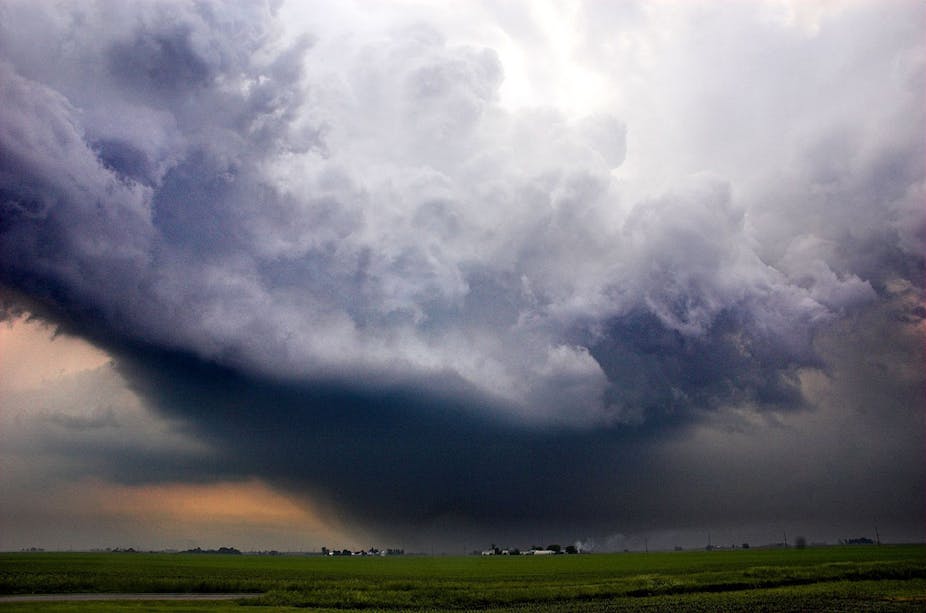Everyone loves a good storm. Rolling thunder, a spectacular light show and fat drops of rain that make the earth smell like summer. Although thunderstorms are far more belligerent than your average cloud, for most of us they simply provide a bit of extra excitement during our day and make the commute home a soggy affair.
But in the Great Plains of the United States, known as Tornado Alley, there is a darker breed of storm, one that truly deserves the title “a force of nature”.
These intense storms, called supercells, can turn day to night, produce blinding rain and hurl hailstones larger than cricket balls at speeds that would put most fast bowlers to shame. But it is a supercell’s final act that is the most aggressive – the tornado.
Although the number fluctuates, the United States generally records over 1000 tornadoes per year.
More than 90% of the tornadoes reported are small, perhaps strong enough to rip a few branches off trees and the roof off a shed.
The remainder (about 10 to 100 per year) cause the most destruction, knocking down houses and in some extreme cases, ripping up their concrete foundations. Violent tornadoes are responsible for an average of 60 deaths per year in the United States.
Tornadoes are both beautiful and destructive. These dichotomous themes are ever-present throughout the film Tornado Alley 3D (which you can see at IMAX cinemas).

The movie follows two teams of storm chasers over the course of a spring “chase season”. This is when supercells are most common in Tornado Alley. Their pursuit of tornado-bearing supercells, the motivations of each team and, of course, the spectacular footage dominates the film.
If you’re looking to find out a little more than the basics of the science behind these storms, this isn’t the film for you. If, however, you want to get up close and personal to a tornado, this is the closest you’ll get without actually being there.
The movie’s first story follows 100-plus scientific researchers collecting data. They want to know why some supercells produce tornadoes and others do not.
Although meteorologists mostly understand how supercells work, the exact cause of tornadoes continues to elude them. Importantly, a better understanding of tornadogenesis will lead directly to improved tornado warning times. These are currently only a few minutes at most.
The second story follows amateur stormchaser (and filmmaker) Sean Casey on a personal quest. Casey is addicted to tornadoes. For the past eight years, he has been on a mission to film a tornado from the inside.
In his backyard operation, Casey has constructed a purpose-built “tank” called the “Tornado Intercept Vehicle”. It weighs 7.5 tonnes, is covered in bulletproof glass and ¼ inch thick steel plating, and includes hydraulic skirts and claws that anchor it to the ground. At times it makes you feel like you’re watching Mad Max rather than IMAX.

But if you’re expecting this film to be an all-action-packed real-life version of the 1996 Hollywood blockbuster “Twister”, you’ll be disappointed (although it is narrated by Twister’s leading man, Bill Paxton).
In reality, storm chasing is an incredibly tricky business. From my personal experience of two chase seasons in Tornado Alley, you can spend days waiting for the right atmospheric conditions to produce a supercell. Even when the conditions look right, there’s no guarantee that a storm will occur. Once, I drove over four hours, one way, and saw nothing but a few wispy clouds.
When supercells eventually form, chasers have to choose between several storms that may be hundreds of miles apart. I once followed a supercell for six hours and it did not produce a single tornado. At the same time, my friends chased another storm less than 100 miles away and saw six.
The film portrayed the true experience of storm chasing wonderfully and once the chase teams were following a tornadic supercell, the IMAX format and 3D came into its own. The adrenaline you feel when seeing a tornado up close is conveyed in vivid detail.
In particular, the focus on Casey’s quest provides visually stunning footage that captures the sheer beauty and raw force of a tornado as never seen before. There are moments you feel you could be there, and some moments that you’re glad you’re not.

The very real footage of homes utterly destroyed and their occupants, who have just lost everything, looking on in shock is a stark reality check. It reminds us of the importance of the work being undertaken by the scientific team.
Throughout the film we are told that the data collected by the scientists will help increase warning times. The film ends with a tone of “mission accomplished”: the scientists have their data, and Casey has his footage. However, the reality is that these are merely steps in an ongoing battle.
It is left unsaid that both teams will return next chase season, continuing to seek further examples of this beautiful yet destructive phenomenon.

